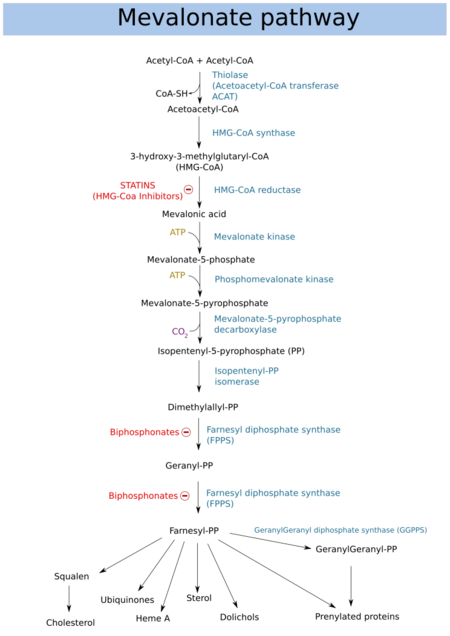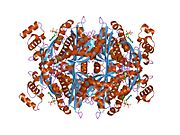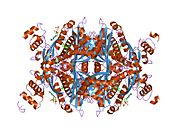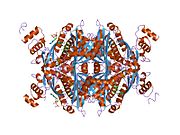Biology:HMG-CoA reductase
 Generic protein structure example |
| hydroxymethylglutaryl-CoA reductase (NADH) | |||||||||
|---|---|---|---|---|---|---|---|---|---|
| Identifiers | |||||||||
| EC number | 1.1.1.88 | ||||||||
| CAS number | 37250-24-1 | ||||||||
| Databases | |||||||||
| IntEnz | IntEnz view | ||||||||
| BRENDA | BRENDA entry | ||||||||
| ExPASy | NiceZyme view | ||||||||
| KEGG | KEGG entry | ||||||||
| MetaCyc | metabolic pathway | ||||||||
| PRIAM | profile | ||||||||
| PDB structures | RCSB PDB PDBe PDBsum | ||||||||
| Gene Ontology | AmiGO / QuickGO | ||||||||
| |||||||||
| hydroxymethylglutaryl-CoA reductase (NADPH) | |||||||||
|---|---|---|---|---|---|---|---|---|---|
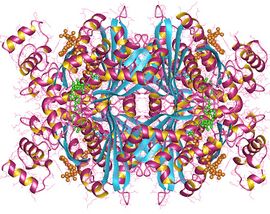 HMG-CoA reductase (NADPH), Human | |||||||||
| Identifiers | |||||||||
| EC number | 1.1.1.34 | ||||||||
| Databases | |||||||||
| IntEnz | IntEnz view | ||||||||
| BRENDA | BRENDA entry | ||||||||
| ExPASy | NiceZyme view | ||||||||
| KEGG | KEGG entry | ||||||||
| MetaCyc | metabolic pathway | ||||||||
| PRIAM | profile | ||||||||
| PDB structures | RCSB PDB PDBe PDBsum | ||||||||
| Gene Ontology | AmiGO / QuickGO | ||||||||
| |||||||||
HMG-CoA reductase (3-hydroxy-3-methyl-glutaryl-coenzyme A reductase, official symbol HMGCR) is the rate-controlling enzyme (NADH-dependent, EC 1.1.1.88; NADPH-dependent, EC 1.1.1.34) of the mevalonate pathway, the metabolic pathway that produces cholesterol and other isoprenoids. HMGCR catalyzes the conversion of HMG-CoA to mevalonic acid, a necessary step in the biosynthesis of cholesterol. Normally in mammalian cells this enzyme is competitively suppressed so that its effect is controlled. This enzyme is the target of the widely available cholesterol-lowering drugs known collectively as the statins, which help treat dyslipidemia.
HMG-CoA reductase is anchored in the membrane of the endoplasmic reticulum, and was long regarded as having seven transmembrane domains, with the active site located in a long carboxyl terminal domain in the cytosol. More recent evidence shows it to contain eight transmembrane domains.[1]
In humans, the gene for HMG-CoA reductase (NADPH) is located on the long arm of the fifth chromosome (5q13.3-14).[2] Related enzymes having the same function are also present in other animals, plants and bacteria.
Structure
The main isoform (isoform 1) of HMG-CoA reductase in humans is 888 amino acids long. It is a polytopic transmembrane protein (meaning it possesses many alpha helical transmembrane segments). It contains two main domains:
- a conserved N-terminal sterol-sensing domain (SSD, amino acid interval: 88–218). The related SSD of SCAP has been shown to bind cholesterol.[3][4]
- a C-terminal catalytic domain (amino acid interval: 489-871), namely the 3-hydroxy-3-methyl-glutaryl-CoA reductase domain. This domain is required for the proper enzymatic activity of the protein.[5]
Isoform 2 is 835 amino acids long. This variant is shorter because it lacks an exon in the middle region (amino acids 522–574). This does not affect any of the aforementioned domains.
Function
HMGCR catalyses the conversion of HMG-CoA to mevalonic acid, a necessary step in the biosynthesis of cholesterol:
Normally in mammalian cells this enzyme is competitively suppressed by cholesterol derived from the internalization and degradation of low density lipoprotein (LDL) via the LDL receptor as well as oxidized species of cholesterol. Competitive inhibitors of the reductase induce the expression of LDL receptors in the liver, which in turn increases the catabolism of plasma LDL and lowers the plasma concentration of cholesterol, which is considered, by those who accept the standard lipid hypothesis, an important determinant of atherosclerosis.[6] This enzyme is thus the target of the widely available cholesterol-lowering drugs known collectively as the statins (see Drugs section for more).
Interactive pathway map
Inhibitors
Drugs
Drugs that inhibit HMG-CoA reductase, known collectively as HMG-CoA reductase inhibitors (or "statins"), are used to lower serum cholesterol as a means of reducing the risk for cardiovascular disease.[7]
These drugs include rosuvastatin (CRESTOR), lovastatin (Mevacor), atorvastatin (Lipitor), pravastatin (Pravachol), fluvastatin (Lescol), pitavastatin (Livalo), and simvastatin (Zocor).[8] Red yeast rice extract, one of the fungal sources from which the statins were discovered, contains several naturally occurring cholesterol-lowering molecules known as monacolins. The most active of these is monacolin K, or lovastatin (previously sold under the trade name Mevacor, and now available as generic lovastatin).[9]
Vytorin is drug that combines the use simvastatin and ezetimibe, which slows the formation of cholesterol by every cell in the body, along with ezetimibe reducing absorption of cholesterol, typically by about 53%, from the intestines.[10]
Statins, HMG-CoA reductase inhibitors, are competent in lowering cholesterol levels and reducing cardiac-related diseases. However, there have been controversies surrounding the potential of statins increasing the risk of new-onset diabetes mellitus (NOD). Experiments have demonstrated that glucose and cholesterol homeostasis are regulated by statins. The HMG-CoA reductase (HMGCR), converts HMG-CoA into mevalonic acid. Thus, when HMGCR activities are reduced, the cell associated cholesterols are also reduced. This results in the activation of SREBP-2-mediated signaling pathways. SREBP-2 activation for cholesterol homeostasis is crucial for the upregulation of low density lipoprotein (LDL) receptor (LDLR). The removal of LDL particles from blood circulation is enhanced when the number of LDLR on hepatocytes increases. Due to the removal of atherogenic lipoprotein particles, such as LDLs and intermediate density lipoproteins, HMGCR inhibitors have been proven to be efficient in reducing cardiovascular diseases from the blood circulation, which is represented by the reduction of LDL-cholesterol levels. In many studies, lipophilic statins are shown as more diabetogenic, possibly due to the fact that they can easily diffuse into cells and inhibit the production of isoprenoids which become more potent. Additionally, statins have been shown to change glucose levels as well.[11]
Hormones
HMG-CoA reductase is active when blood glucose is high. The basic functions of insulin and glucagon are to maintain glucose homeostasis. Thus, in controlling blood sugar levels, they indirectly affect the activity of HMG-CoA reductase, but a decrease in activity of the enzyme is caused by AMP-activated protein kinase,[12] which responds to an increase in AMP concentration, and also to leptin.
Clinical significance
Since the reaction catalysed by HMG-CoA reductase is the rate-limiting step in cholesterol synthesis, this enzyme represents the sole major drug target for contemporary cholesterol-lowering drugs in humans. The medical significance of HMG-CoA reductase has continued to expand beyond its direct role in cholesterol synthesis following the discovery that statins can offer cardiovascular health benefits independent of cholesterol reduction.[13] Statins have been shown to have anti-inflammatory properties,[14] most likely as a result of their ability to limit production of key downstream isoprenoids that are required for portions of the inflammatory response. It can be noted that blocking of isoprenoid synthesis by statins has shown promise in treating a mouse model of multiple sclerosis, an inflammatory autoimmune disease.[15]
Inhibition of HMG-CoA reductase by statins is lessened in patients with type 2 diabetes, which results in lessened inhibition of coronary atheromatous plaque, development.[16]
HMG-CoA reductase is an important developmental enzyme. Inhibition of its activity and the concomitant lack of isoprenoids that yields can lead to germ cell migration defects[17] as well as intracerebral hemorrhage.[18]
Homozygous mutation of HMGCR can lead to a form of limb girdle myopathy that may share features with mild statin-induced myopathy. The clinical syndrome was partially reversed in a model system by supplementation with the downstream metabolite mevalonolactone.[19]
The presence of anti HMG-CoA reductase antibodies is seen in people with statin-associated autoimmune myopathy, which is a very rare form of muscle damage caused by the immune system in people who take statin medications.[20] The exact mechanism is unclear. A combination of consistent findings on physical examination, the presence of anti HMG-CoA reductase antibodies in a person with myopathy, evidence of muscle breakdown, and muscle biopsy diagnose SAAM.[21]
Regulation

Regulation of HMG-CoA reductase is achieved at several levels: transcription, translation, degradation and phosphorylation.
Transcription
Transcription of the reductase gene is enhanced by the sterol regulatory element binding protein (SREBP). This protein binds to the sterol regulatory element (SRE), located on the 5' end of the reductase gene after controlled proteolytic processing. When SREBP is inactive, it is bound to the ER or nuclear membrane with another protein called SREBP cleavage-activating protein (SCAP). SCAP senses low cholesterol concentration and transports SREBP to the Golgi membrane where a consecutive proteolysis by S1P and S2P cleaves SREBP into an active nuclear form, nSREBP. nSREBPs migrate to the nucleus and activate transcription of SRE-containing genes. The nSREBP transcription factor is short-lived. When cholesterol levels rise, Insigs retains the SCAP-SREBP complex in the ER membrane by preventing its incorporation into COPII vesicles.[22][23]
Translation
Translation of mRNA is inhibited by a mevalonate derivative, which has been reported to be the isoprenoid farnesol,[24][25] although this role has been disputed.[26]
Degradation
Rising levels of sterols increase the susceptibility of the reductase enzyme to ER-associated degradation (ERAD) and proteolysis. Helices 2-6 (total of 8) of the HMG-CoA reductase transmembrane domain are thought to sense increased cholesterol levels (direct sterol binding to the SSD of HMG-CoA reductase has not been demonstrated). Lysine residues 89 and 248 can become ubiquinated by ER-resident E3 ligases. The identity of the multiple E3 ligases involved in HMG-CoA degradation is controversial, with suggested candidates being AMFR,[27] Trc8,[28] and RNF145[29][30] The involvement of AMFR and Trc8 has been contested.[31]
Phosphorylation
Short-term regulation of HMG-CoA reductase is achieved by inhibition by phosphorylation (of Serine 872, in humans[32]). Decades ago it was believed that a cascade of enzymes controls the activity of HMG-CoA reductase: an HMG-CoA reductase kinase was thought to inactivate the enzyme, and the kinase in turn was held to be activated via phosphorylation by HMG-CoA reductase kinase kinase. An excellent review on regulation of the mevalonate pathway by Nobel Laureates Joseph Goldstein and Michael Brown adds specifics: HMG-CoA reductase is phosphorylated and inactivated by an AMP-activated protein kinase, which also phosphorylates and inactivates acetyl-CoA carboxylase, the rate-limiting enzyme of fatty acid biosynthesis.[33] Thus, both pathways utilizing acetyl-CoA for lipid synthesis are inactivated when energy charge is low in the cell, and concentrations of AMP rise. There has been a great deal of research on the identity of upstream kinases that phosphorylate and activate the AMP-activated protein kinase.[34]
Fairly recently, LKB1 has been identified as a likely AMP kinase kinase,[35] which appears to involve calcium/calmodulin signaling. This pathway likely transduces signals from leptin, adiponectin, and other signaling molecules.[34]
See also
References
- ↑ "Immunological evidence for eight spans in the membrane domain of 3-hydroxy-3-methylglutaryl coenzyme A reductase: implications for enzyme degradation in the endoplasmic reticulum". The Journal of Cell Biology 117 (5): 959–973. June 1992. doi:10.1083/jcb.117.5.959. PMID 1374417.
- ↑ "Human genes involved in cholesterol metabolism: chromosomal mapping of the loci for the low density lipoprotein receptor and 3-hydroxy-3-methylglutaryl-coenzyme A reductase with cDNA probes". Proceedings of the National Academy of Sciences of the United States of America 82 (24): 8567–8571. December 1985. doi:10.1073/pnas.82.24.8567. PMID 3866240. Bibcode: 1985PNAS...82.8567L.
- ↑ "Retrospective on Cholesterol Homeostasis: The Central Role of Scap". Annual Review of Biochemistry 87: 783–807. June 2018. doi:10.1146/annurev-biochem-062917-011852. PMID 28841344.
- ↑ "Direct binding of cholesterol to the purified membrane region of SCAP: mechanism for a sterol-sensing domain". Molecular Cell 15 (2): 259–268. July 2004. doi:10.1016/j.molcel.2004.06.019. PMID 15260976.
- ↑ "Computational study of conformational changes in human 3-hydroxy-3-methylglutaryl coenzyme reductase induced by substrate binding". Journal of Biomolecular Structure & Dynamics 37 (16): 4374–4383. October 2019. doi:10.1080/07391102.2018.1549508. PMID 30470158.
- ↑ "Entrez Gene: HMGCR 3-hydroxy-3-methylglutaryl-Coenzyme A reductase". https://www.ncbi.nlm.nih.gov/sites/entrez?Db=gene&Cmd=ShowDetailView&TermToSearch=3156.
- ↑ "Aggressive lipid therapy in the statin era". Progress in Cardiovascular Diseases 41 (2): 71–94. 1998. doi:10.1016/S0033-0620(98)80006-6. PMID 9790411.
- ↑ "Is there a "best" statin drug?". The Johns Hopkins Medical Letter Health After 50 15 (11): 4–5. January 2004. PMID 14983817.
- ↑ "Biologically active components and nutraceuticals in the Monascus-fermented rice: a review". Applied Microbiology and Biotechnology 77 (5): 965–973. January 2008. doi:10.1007/s00253-007-1256-6. PMID 18038131. http://ntur.lib.ntu.edu.tw/bitstream/246246/215068/-1/b.pdf.
- ↑ "Ezetimibe + simvastatin (Merck/Schering-Plough)". Current Opinion in Investigational Drugs 5 (9): 984–992. September 2004. PMID 15503655.
- ↑ "Functional Implications of HMG-CoA Reductase Inhibition on Glucose Metabolism". Korean Circulation Journal (The Korean Society of Cardiology) 48 (11): 951–963. November 2018. doi:10.4070/kcj.2018.0307. PMID 30334382.
- ↑ "Regulation of fatty acid and cholesterol metabolism by the AMP-activated protein kinase". Biochimica et Biophysica Acta (BBA) - Lipids and Lipid Metabolism 1123 (3): 231–238. February 1992. doi:10.1016/0005-2760(92)90001-c. PMID 1536860.
- ↑ "Cholesterol-independent effects of statins in inflammation, immunomodulation and atherosclerosis". Current Drug Targets - Cardiovascular & Hematological Disorders 5 (2): 127–134. April 2005. doi:10.2174/1568006043586198. PMID 15853754.
- ↑ "Nonlipid-lowering effects of statins". Current Treatment Options in Cardiovascular Medicine 7 (6): 459–466. December 2005. doi:10.1007/s11936-005-0031-1. PMID 16283973.
- ↑ "Statins as potential therapeutic agents in neuroinflammatory disorders". Current Opinion in Neurology 16 (3): 393–401. June 2003. doi:10.1097/00019052-200306000-00021. PMID 12858078.
- ↑ "Potential Alteration of Statin-Related Pharmacological Features in Diabetes Mellitus". BioMed Research International 2021: 6698743. 2021. doi:10.1155/2021/6698743. PMID 33834073.
- ↑ "Germ cell migration in zebrafish is dependent on HMGCoA reductase activity and prenylation". Developmental Cell 6 (2): 295–302. February 2004. doi:10.1016/S1534-5807(04)00032-2. PMID 14960282.
- ↑ "The 3-hydroxy-3-methylglutaryl-CoA reductase (HMGCR) pathway regulates developmental cerebral-vascular stability via prenylation-dependent signalling pathway". Developmental Biology 373 (2): 258–266. January 2013. doi:10.1016/j.ydbio.2012.11.024. PMID 23206891.
- ↑ "Limb girdle muscular disease caused by HMGCR mutation and statin myopathy treatable with mevalonolactone". Proc Natl Acad Sci U S A 120 (7): e2217831120. February 2023. doi:10.1073/pnas.2217831120. PMID 36745799. Bibcode: 2023PNAS..12017831Y.
- ↑ "Statin-Associated Side Effects". Journal of the American College of Cardiology 67 (20): 2395–2410. May 2016. doi:10.1016/j.jacc.2016.02.071. PMID 27199064.
- ↑ "Statin-Associated Autoimmune Myopathy". The New England Journal of Medicine 374 (7): 664–669. February 2016. doi:10.1056/NEJMra1515161. PMID 26886523.
- ↑ "Sterol-regulated transport of SREBPs from endoplasmic reticulum to Golgi: Insig renders sorting signal in Scap inaccessible to COPII proteins". Proceedings of the National Academy of Sciences of the United States of America 104 (16): 6519–6526. April 2007. doi:10.1073/pnas.0700907104. PMID 17428919. Bibcode: 2007PNAS..104.6519S.
- ↑ "Insig required for sterol-mediated inhibition of Scap/SREBP binding to COPII proteins in vitro". The Journal of Biological Chemistry 280 (28): 26483–26490. July 2005. doi:10.1074/jbc.M504041200. PMID 15899885.
- ↑ "Regulation of 3-hydroxy-3-methylglutaryl-coenzyme A reductase degradation by the nonsterol mevalonate metabolite farnesol in vivo". The Journal of Biological Chemistry 271 (14): 7916–7922. April 1996. doi:10.1074/jbc.271.14.7916. PMID 8626470.
- ↑ "Farnesol as a regulator of HMG-CoA reductase degradation: characterization and role of farnesyl pyrophosphatase". Archives of Biochemistry and Biophysics 345 (1): 1–9. September 1997. doi:10.1006/abbi.1997.0200. PMID 9281305.
- ↑ "Farnesol is not the nonsterol regulator mediating degradation of HMG-CoA reductase in rat liver". Archives of Biochemistry and Biophysics 328 (2): 324–330. April 1996. doi:10.1006/abbi.1996.0180. PMID 8645011.
- ↑ "Gp78, a membrane-anchored ubiquitin ligase, associates with Insig-1 and couples sterol-regulated ubiquitination to degradation of HMG CoA reductase". Molecular Cell 19 (6): 829–840. September 2005. doi:10.1016/j.molcel.2005.08.009. PMID 16168377.
- ↑ "Sterol-induced degradation of HMG CoA reductase depends on interplay of two Insigs and two ubiquitin ligases, gp78 and Trc8". Proceedings of the National Academy of Sciences of the United States of America 108 (51): 20503–20508. December 2011. doi:10.1073/pnas.1112831108. PMID 22143767. Bibcode: 2011PNAS..10820503J.
- ↑ "Ring finger protein 145 (RNF145) is a ubiquitin ligase for sterol-induced degradation of HMG-CoA reductase". The Journal of Biological Chemistry 293 (11): 4047–4055. March 2018. doi:10.1074/jbc.RA117.001260. PMID 29374057.
- ↑ "The sterol-responsive RNF145 E3 ubiquitin ligase mediates the degradation of HMG-CoA reductase together with gp78 and Hrd1". eLife 7. December 2018. doi:10.7554/eLife.40009. PMID 30543180.
- ↑ "Differential regulation of HMG-CoA reductase and Insig-1 by enzymes of the ubiquitin-proteasome system". Molecular Biology of the Cell 23 (23): 4484–4494. December 2012. doi:10.1091/mbc.E12-08-0631. PMID 23087214.
- ↑ "Crystal structure of the catalytic portion of human HMG-CoA reductase: insights into regulation of activity and catalysis". The EMBO Journal 19 (5): 819–830. March 2000. doi:10.1093/emboj/19.5.819. PMID 10698924.
- ↑ "Regulation of the mevalonate pathway". Nature 343 (6257): 425–430. February 1990. doi:10.1038/343425a0. PMID 1967820. Bibcode: 1990Natur.343..425G.
- ↑ 34.0 34.1 "Management of cellular energy by the AMP-activated protein kinase system". FEBS Letters 546 (1): 113–120. July 2003. doi:10.1016/S0014-5793(03)00560-X. PMID 12829246.
- ↑ "Chutes and Ladders: the search for protein kinases that act on AMPK". Trends in Biochemical Sciences 31 (1): 13–16. January 2006. doi:10.1016/j.tibs.2005.11.009. PMID 16356723.
Further reading
- "Normal cholesterol synthesis in human cells requires functional peroxisomes". Biochemical and Biophysical Research Communications 181 (2): 537–541. December 1991. doi:10.1016/0006-291X(91)91222-X. PMID 1755834.
- "Characterization of three distinct size classes of human 3-hydroxy-3-methylglutaryl coenzyme A reductase mRNA: expression of the transcripts in hepatic and nonhepatic cells". DNA and Cell Biology 9 (9): 677–690. November 1990. doi:10.1089/dna.1990.9.677. PMID 1979742.
- "Regulation of HMG-CoA reductase: identification of the site phosphorylated by the AMP-activated protein kinase in vitro and in intact rat liver". The EMBO Journal 9 (8): 2439–2446. August 1990. doi:10.1002/j.1460-2075.1990.tb07420.x. PMID 2369897.
- "Human 3-hydroxy-3-methylglutaryl coenzyme A reductase. Conserved domains responsible for catalytic activity and sterol-regulated degradation". The Journal of Biological Chemistry 260 (18): 10271–10277. August 1985. doi:10.1016/S0021-9258(17)39242-6. PMID 2991281.
- "The isolation, characterisation, and chromosomal assignment of the gene for human 3-hydroxy-3-methylglutaryl coenzyme A reductase, (HMG-CoA reductase)". Human Genetics 71 (3): 254–258. 1986. doi:10.1007/BF00284585. PMID 2998972.
- "Phosphorylation and modulation of the enzymic activity of native and protease-cleaved purified hepatic 3-hydroxy-3-methylglutaryl-coenzyme A reductase by a calcium/calmodulin-dependent protein kinase". The Journal of Biological Chemistry 262 (27): 13228–13240. September 1987. doi:10.1016/S0021-9258(18)45191-5. PMID 3308873.
- "5' end of HMG CoA reductase gene contains sequences responsible for cholesterol-mediated inhibition of transcription". Cell 42 (1): 203–212. August 1985. doi:10.1016/S0092-8674(85)80116-1. PMID 3860301.
- "Human genes involved in cholesterol metabolism: chromosomal mapping of the loci for the low density lipoprotein receptor and 3-hydroxy-3-methylglutaryl-coenzyme A reductase with cDNA probes". Proceedings of the National Academy of Sciences of the United States of America 82 (24): 8567–8571. December 1985. doi:10.1073/pnas.82.24.8567. PMID 3866240. Bibcode: 1985PNAS...82.8567L.
- "Characterization of 3-hydroxy-3-methylglutaryl coenzyme A reductase in human adrenal cortex". Endocrinology 117 (4): 1462–1468. October 1985. doi:10.1210/endo-117-4-1462. PMID 3896758.
- "HMG-CoA reductase activity in the microsomal fraction from human placenta in early and term pregnancy". The International Journal of Biochemistry 16 (9): 1023–1026. 1984. doi:10.1016/0020-711X(84)90120-4. PMID 6479432.
- "Measurement of human leukocyte microsomal HMG-CoA reductase activity". Journal of Lipid Research 25 (9): 967–978. September 1984. doi:10.1016/S0022-2275(20)37733-6. PMID 6491541.
- "Deficient ileal 3-hydroxy-3-methylglutaryl coenzyme A reductase activity in sitosterolemia: sitosterol is not a feedback inhibitor of intestinal cholesterol biosynthesis". Metabolism 43 (7): 855–859. July 1994. doi:10.1016/0026-0495(94)90266-6. PMID 8028508.
- "Importance of mevalonate-derived products in the control of HMG-CoA reductase activity and growth of human lung adenocarcinoma cell line A549". International Journal of Cancer 55 (4): 640–645. October 1993. doi:10.1002/ijc.2910550421. PMID 8406993.
- "HMG-CoA reductase guides migrating primordial germ cells". Nature 396 (6710): 466–469. December 1998. doi:10.1038/24871. PMID 9853754. Bibcode: 1998Natur.396..466V.
- "Characterization of single-nucleotide polymorphisms in coding regions of human genes". Nature Genetics 22 (3): 231–238. July 1999. doi:10.1038/10290. PMID 10391209.
- "Role of peroxisomes in isoprenoid biosynthesis". The Journal of Histochemistry and Cytochemistry 47 (9): 1127–1132. September 1999. doi:10.1177/002215549904700904. PMID 10449533.
- "3-Hydroxy-3-methylglutaryl-coenzyme A reductase activity is inhibited by cholesterol and up-regulated by sitosterol in sitosterolemic fibroblasts". The Journal of Laboratory and Clinical Medicine 135 (2): 174–179. February 2000. doi:10.1067/mlc.2000.104459. PMID 10695663.
- "Structural mechanism for statin inhibition of HMG-CoA reductase". Science 292 (5519): 1160–1164. May 2001. doi:10.1126/science.1059344. PMID 11349148. Bibcode: 2001Sci...292.1160I.
- "Diverse effects of inhibition of 3-hydroxy-3-methylglutaryl-CoA reductase on the expression of VCAM-1 and E-selectin in endothelial cells". The Biochemical Journal 360 (Pt 2): 363–370. December 2001. doi:10.1042/0264-6021:3600363. PMID 11716764.
External links
- Cholesterol Synthesis - has some good regulatory details
- Proteopedia HMG-CoA_Reductase - the HMG-CoA Reductase Structure in Interactive 3D
- Overview of all the structural information available in the PDB for UniProt: P04035 (3-hydroxy-3-methylglutaryl-coenzyme A reductase) at the PDBe-KB.
 |
